Are you a massive fan of the delightful delicacy known as poke? If so, you’ve likely been juggling the question, “how long does poke last in the fridge?”
We’ve all been there. After all, wasting food is not an option, and we all want to savor our favored dishes for as long as possible.
This article explores the longevity of poke in the refrigerator and provides tips to help preserve your poke for extended durations.

We’ll delve into a discussion about food safety, ways to detect if your poke is still good to eat, and what determines the shelf-life of this popular dish. Stay with us as we venture into the delicious realm of poke preservation.
Quick Recommendations
Last update on 2025-10-24 / Affiliate links / Images from Amazon Product Advertising API
How long does poke last in the fridge?
The shelf-life of Poke in the fridge isn’t significantly long. As a rule of thumb, consume your poke within 24-48 hours for maximum freshness and safety. Given that poke is a raw fish dish, it’s highly perishable and shouldn’t be kept for a prolong period.
If stored properly, it can last up to 2 days, but the quality and safety quickly deteriorate after that point. Remember, if poke has an unusual odor or texture, discarding it to avoid foodborne illnesses is safer.
If you cannot consume poke within this timeframe, it’s recommended to freeze it immediately after purchase or preparation.
How long is poke good for out of the fridge?
Raw fish, like poke, are potentially hazardous foods that must be treated cautiously. The Food and Drug Administration guidelines suggest that poke, like any raw seafood, should not be left out of the refrigerator for more than 2 hours.

If the temperature outside is at or above 90°F, such as during a hot summer day, poke should be refrigerated or consumed within one hour. Always be mindful of these timeframes as bacteria can multiply rapidly at room temperature, which may lead to foodborne illnesses.
How to reheat a poke bowl?
A poke bowl is a delicious, chilled dish typically served with fresh, raw fish. While it’s commonly consumed cold, you might prefer it warm, especially if it contains cooked components like rice or veggies.
Here’s a step-by-step guide to help you reheat your poke bowl without compromising its taste and quality.
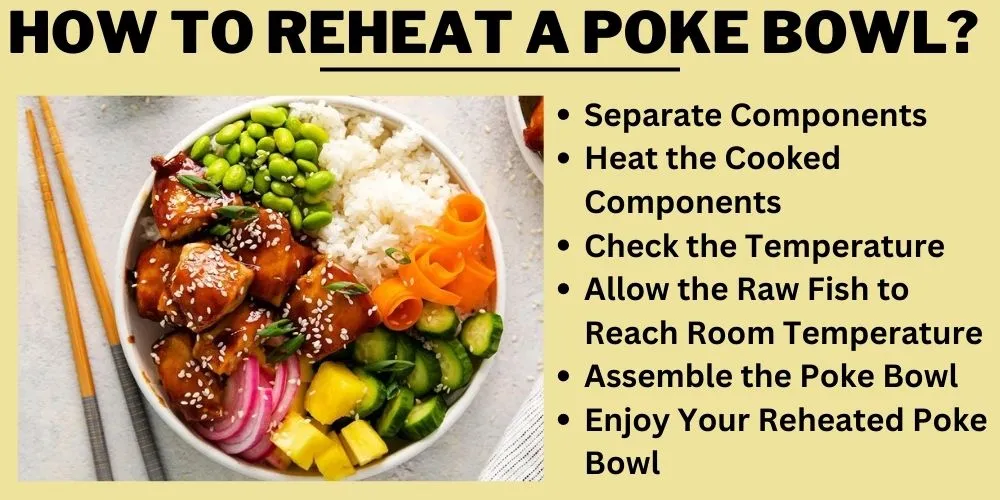
Separate Components
Start by separating the raw fish from the cooked elements like rice, vegetables, and other toppings in the bowl. It’s essential to protect the texture and quality of the fish during the reheating process.
Heat the Cooked Components
Place the cooked ingredients, such as rice and vegetables, in a microwave-safe dish, and cover them with a microwave-safe lid or a wet paper towel. This will help to retain moisture, preventing the rice and veggies from drying out when reheated.
Reheat the cooked components for 60 to 90 seconds using a microwave. You can also use a saucepan or a skillet on a stovetop. Add a splash of water to keep components moist. Depending on the quantity, stirring occasionally, heat the ingredients on medium heat for about 4-5 minutes.
Check the Temperature
Using a food thermometer, check that the cooked components have reached a temperature of at least 165°F, the recommended temperature for safe consumption.
Allow the Raw Fish to Reach Room Temperature
While the cooked components are being heated, set the raw fish aside, allowing them to come to room temperature. You can leave the fish pieces on the counter or place them in a sealed bag and submerge them in a bowl of lukewarm water. This step ensures the fish isn’t too cold when eaten.
Assemble the Poke Bowl
Once the rice and vegetables are heated, transfer them to a bowl. Layer your raw fish and preferred toppings over the warmed base. To enhance the flavor, consider adding additional ingredients, such as green onions, sesame seeds, or a drizzle of sauce.
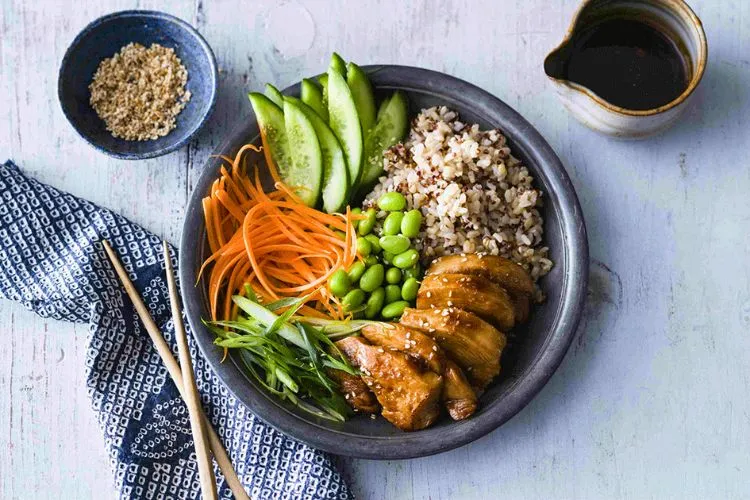
Enjoy Your Reheated Poke Bowl
Your reheated poke bowl is now ready to enjoy. Indulge immediately for the best taste and texture.
How Do You Know If Poke Is Bad?
Poke is a Hawaiian raw seafood dish often made from tuna or salmon, combined with rice and various other flavorsome ingredients. As with any raw fish, it’s vital to recognize the signs of spoilage to avoid potential foodborne illnesses.
This comprehensive guide will walk you through what to look for when determining whether your poke is still good to consume.
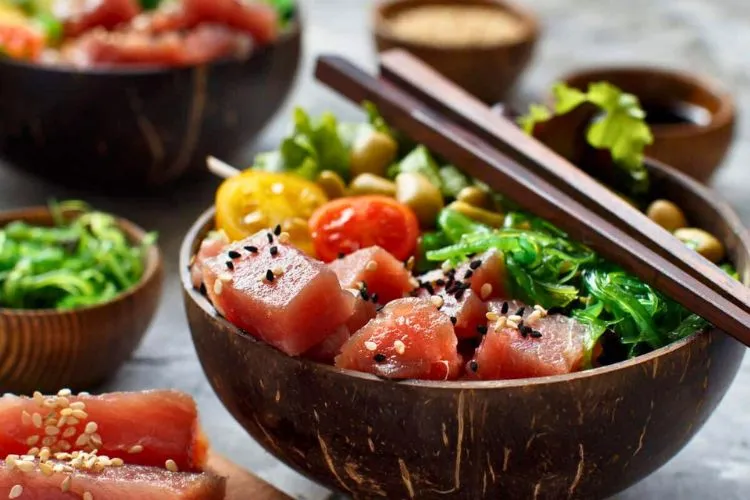
- Texture: Meticulously assessing the texture of the fish will enable you to identify warning signs of spoilage. Fresh poke should have a firm, smooth, and slightly elastic texture. It could indicate that the fish has gone bad if it feels excessively slimy, sticky, or mushy.
- Color: Evaluate the color of the fish. It should appear vibrant, with its natural hue reflecting freshness. Over time, fish becomes dull and may even develop a brownish-grey tinge. If you notice any distinct discoloration or fading, it’s probably best to avoid consumption.
- Smell: The scent of the fish is a telltale sign of its quality. Fresh poke should have a mild, slightly ocean-like aroma. If you notice any strong, ammonia-like, or pungent odors, it’s safe to assume that the fish has likely spoiled and should not be consumed.
- Taste: If you’re still uncertain about the poke’s freshness after assessing the texture, color, and smell, take a small taste. Fresh poke should taste fresh and sweet, with no sour or rancid undertones. Remember that eating spoiled poke can lead to food-related illnesses, so only resort to tasting once you’re sure there are no other indications of spoilage. Immediately discard the poke if it tastes off or unpleasant.
- Expiration Date: Always pay attention to the expiration date on the packaging, especially if it’s store-bought poke. Consume the poke before the use-by or best-before date indicated on the label to ensure its freshness and safety.
- Storage Conditions: Proper storage is crucial in maintaining the quality of poke. If the fish wasn’t adequately refrigerated (below 40°F) or left out of the fridge for longer than recommended, it’s safer to discard it.
Recap:
Spotting spoiled poke involves thoroughly checking the following:
- Texture: Should be firm, smooth, and slightly elastic
- Color: Should be vibrant, with no distinct discoloration or fading
- Smell: Should have a mild, slightly ocean-like aroma; avoid if it smells sour, rancid, or like ammonia
- Taste: Should taste fresh and slightly sweet, with no sour or rancid undertones
- Expiration Date: Consume before the use-by or best-before date
- Storage Conditions: Ensure proper refrigeration and minimal exposure to room temperature
What Does Expired Poke Look Like?
Recognizing expired poke is crucial for avoiding any potential health risks. You must consider here when determining if your poke is no longer safe to consume.
- Discolored Appearance: The color of fresh poke is typically vibrant and reflective of the fish’s natural hue. Over time, as fish spoils, its color can change, often acquiring a dull appearance or even a brownish-grey tinge. Expired poke will no longer showcase its original bright color and might have noticeable discoloration.
- Loss of Firmness: Fresh poke will have a firm, smooth texture, maintaining a certain level of elasticity. When poke is no longer fresh, the texture often degenerates, turning mushy or sticky as the fish starts to break down. Any unusual or unfavorable changes in texture can be a strong indication of expired poke.
- Sliminess: A slimy film covering the poke is another sign of spoilage. This slime may be a slippery or sticky layer that coats the fish. Consuming poke with a slimy surface should be avoided, as it indicates that the fish is likely past its prime.
- Unpleasant Odor: Fresh poke should have a mildly oceanic or fish-like scent. When poke goes bad, it emits a sour, rotten, or strong ammonia-like odor. If you detect such an off-putting smell, it’s safe to assume that the poke has expired and should be discarded.
What Happens If You Eat Expired Poke?
Like any spoiled raw or partially cooked seafood, consuming expired poke can harm your health. Here’s what may happen if you consume expired poke:
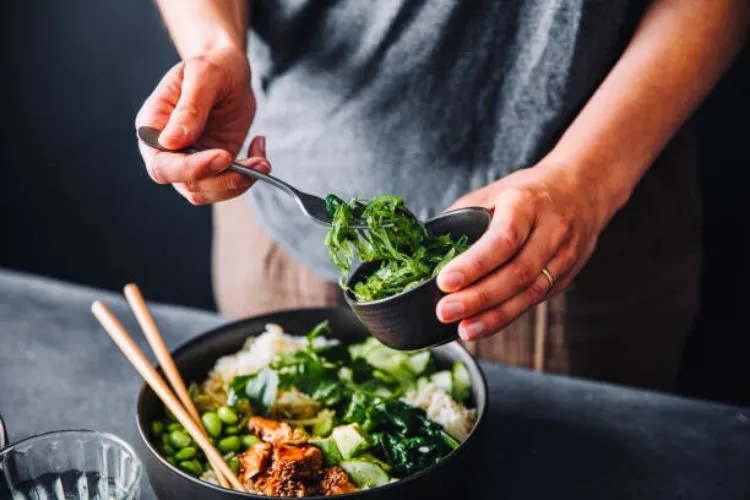
Foodborne Illnesses
Spoiled poke can harbor harmful bacteria, such as Salmonella, E. coli, or Listeria, leading to foodborne illnesses. Symptoms commonly associated with foodborne illnesses include:
- Nausea
- Vomiting
- Diarrhea
- Abdominal pain or cramps
- Fever
- Chills
- Weakness
Depending on the type of bacteria, these symptoms typically manifest within a few hours to a couple of days after consuming the contaminated food. The severity and duration of symptoms can vary among individuals.
Allergic Reactions
In some cases, expired seafood can produce histamine as a natural byproduct of spoilage. This histamine can, in turn, cause scombroid poisoning, a type of histamine fish poisoning that can trigger allergy-like symptoms, such as:
- Flushing or redness of the face/body
- Hives
- Itching
- Swelling
- Headache
- Dizziness
- Rapid and/or irregular heartbeat
Scombroid poisoning symptoms usually arise within minutes to hours following consumption of the tainted seafood.
Dehydration and Hospitalization
Significant fluid loss due to diarrhea and vomiting can lead to dehydration. If symptoms persist or become severe, medical attention may be necessary, potentially leading to hospitalization to ensure proper rehydration and recovery.
What are the risks of storing poke?
Poke is a popular Hawaiian raw fish dish often made with tuna, salmon, or other seafood, and served with rice and an assortment of flavorful toppings. Storing poke can pose risks if not done correctly, potentially affecting the dish’s taste, quality, and safety. Here, we explore risks associated with storing poke and how to mitigate them.
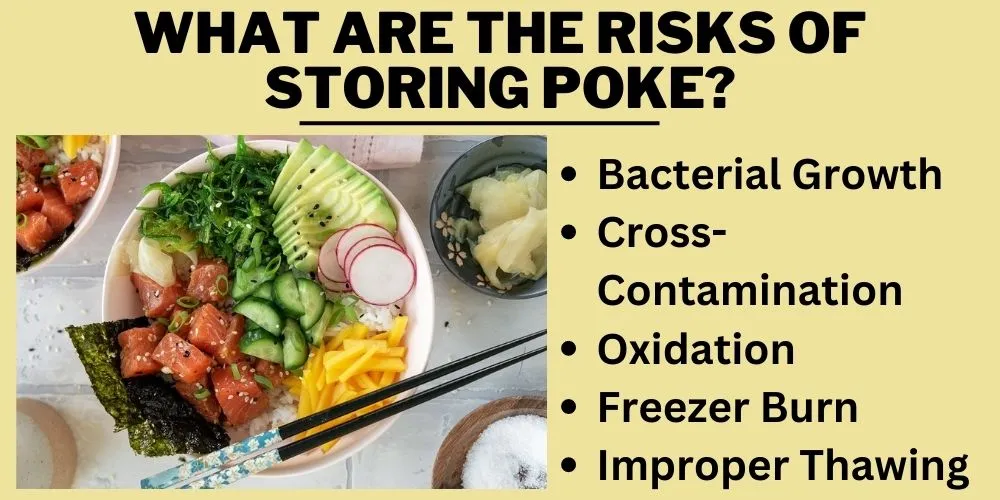
Bacterial Growth
The primary risk when storing raw seafood like poke is bacterial growth. Incorrect storage conditions, such as inadequate refrigeration or exposure to air, can cause harmful bacteria to multiply, potentially leading to foodborne illnesses.
How to reduce the risk:
- Store poke properly in an airtight container below 40°F (4°C).
- Consume poke within 24-48 hours of purchase or preparation.
- Do not leave poke at room temperature for more than two hours.
Cross-Contamination
Cross-contamination can occur when storing poke with other foods, enabling the transfer of harmful microorganisms between raw and cooked or ready-to-eat items.
How to reduce the risk:
- Keep poke in a separate, sealed container away from other foods.
- Use a designated area in your refrigerator for raw seafood to prevent contact with other items.
- Wash hands, utensils, and surfaces thoroughly before and after handling poke to avoid contamination.
Oxidation
Poke can undergo oxidation when exposed to the air for extended periods, leading to a decline in flavor, color, and overall quality.
How to reduce the risk:
- Limit exposure to air by sealing poke in airtight containers or using plastic wrap to cover containers tightly.
- Fill storage containers with minimal airspace, but avoid overpacking to prevent crushing or texture-related issues.
Freezer Burn
When stored in the freezer for too long or without proper protection, poke can develop freezer burn, which affects texture and taste.
How to reduce the risk:
- Wrap poke securely with plastic wrap or aluminum foil before placing it in an airtight container or freezer-safe bag.
- Clearly label containers or bags with the date and contents.
- Consume frozen poke within two months, as the quality may degrade beyond that point.
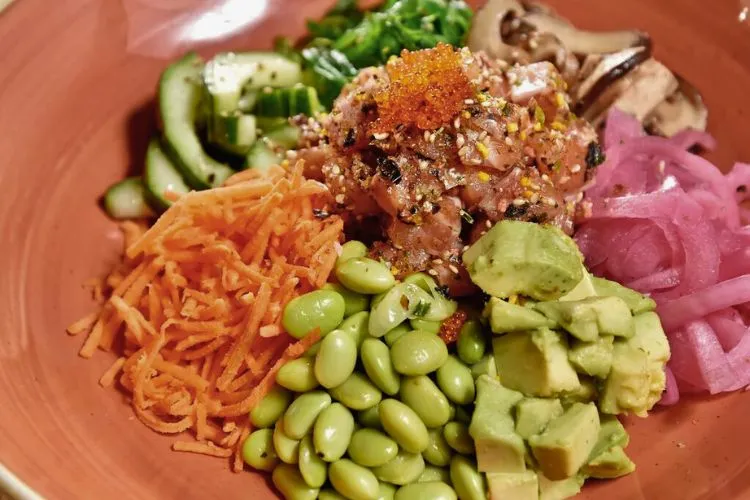
Improper Thawing
Thawing pokes at room temperature or submerging in warm water can encourage bacterial growth and compromise food safety.
How to reduce the risk:
- Thaw frozen poke in the refrigerator below 40°F (4°C) for 24 hours.
- If necessary, use the microwave’s defrost setting, but consume poke immediately after thawing to avoid bacterial growth.
- Alternatively, thaw poke in a sealed plastic bag submerged in cold water, changing the water every 30 minutes.
frequently asked question (FAQs)
Can you eat 2-day-old poke?
Answer: Yes, you can eat 2-day-old poke if it’s been properly stored in the refrigerator. Poke generally maintains its best quality and safety if consumed within 24-48 hours when stored correctly below 40°F (4°C). However, examining its appearance, smell, and texture before consuming is important, as these can indicate potential spoilage.
Can you eat poke the next day?
Answer: Absolutely, poke is safe to eat the next day if it’s been appropriately stored in the fridge after purchasing or preparing it. But, it’s always a good practice to check its texture, color, and smell before consumption to ensure freshness.
What to do with leftover poke?
Answer: Leftover poke can still be used in a variety of dishes. You could make poke bowls by adding rice, greens, and other toppings. It can also be added to salads, sushi rolls, or wraps. If poke is near or beyond its safety window (24-48 hours), it should be discarded to avoid potential foodborne illnesses. Always check for signs of spoilage before using.
Conclusion:
In conclusion, the freshness and safety of poke are best maintained when it is properly stored in the refrigerator at temperatures below 40°F (4°C). While poke’s peak quality is often upheld within the first 24 hours, it can generally last safely for 24-48 hours.
Beyond this, the risk of spoilage and potential foodborne illnesses significantly increases.
Consequently, it’s vital to keenly observe poke’s texture, smell, and appearance before consuming it, especially as it passes the 24-hour mark. Proper storage and timely consumption are key to enjoying poke at its best.





